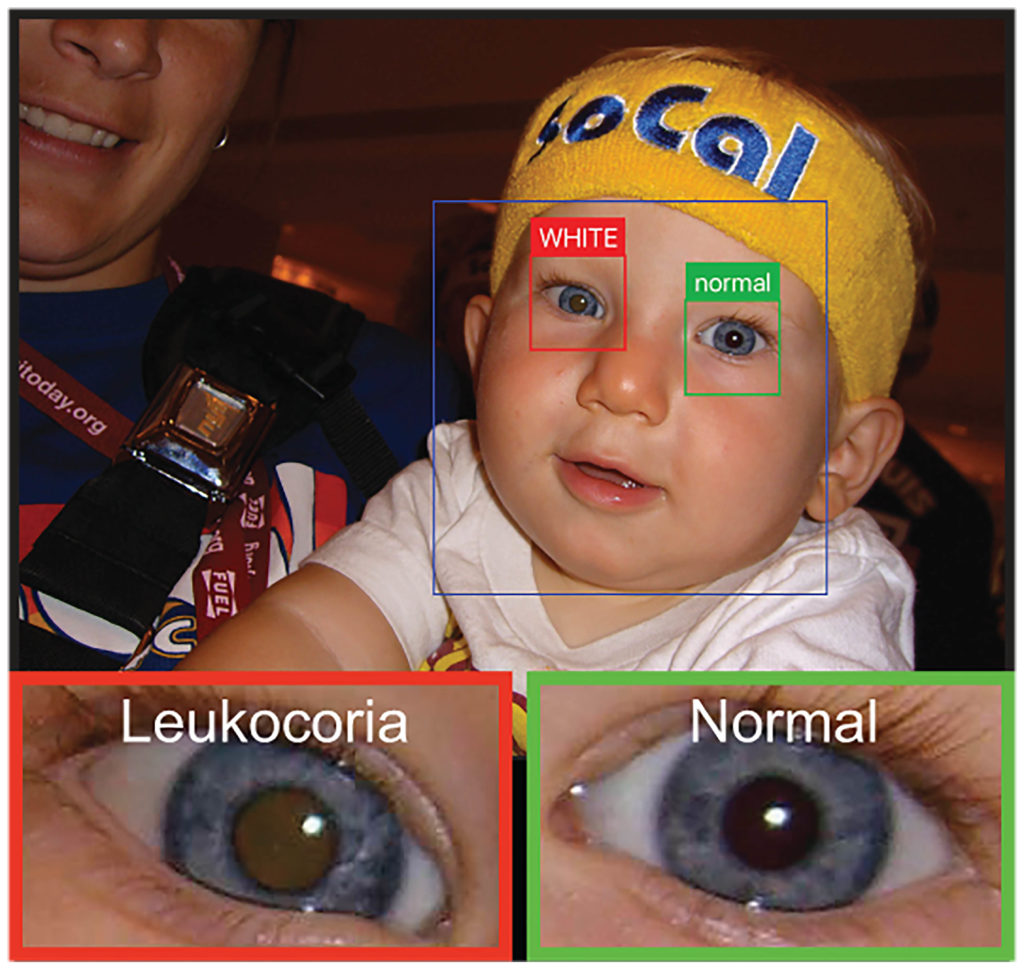A Baylor University researcher’s prototype smartphone app — designed to help parents detect early signs of various eye diseases in their children such as retinoblastoma, an aggressive pediatric eye cancer — has passed its first big test.
The CRADLE app (ComputeR Assisted Detector LEukocoia) searches for traces of abnormal reflections from the retina called leukocoria or “white eye,” a primary symptom of retinoblastoma, as well as other common eye disorders. The study, published in the journal Science Advances, found the app is an effective tool to augment clinical leukocoria screenings, allowing parents to efficiently and effectively screen their children more often throughout their development.
CRADLE — developed by Baylor University researchers Bryan F. Shaw, Ph.D., professor of chemistry and biochemistry, along with Greg Hamerly, Ph.D., associate professor of computer science — searches through family photographs for signs of leukocoria.
According to the study’s first author, Baylor senior University Scholar Micheal Munson, researchers determined the sensitivity, specificity and accuracy of the prototype by analyzing more than 50,000 photographs of children taken prior to their diagnosis. For children with diagnosed eye disorders, CRADLE was able to detect leukocoria for 80 percent of the children. The app detected leukocoria in photos that were taken on average of 1.3 years prior to their official diagnosis.
The effectiveness of traditional screenings during a general physical exam is limited, with signs of retinoblastoma via the detection of leukocoria in only 8 percent of cases. CRADLE’s sensitivity for children age 2 and younger surpassed 80 percent. That 80 percent threshold is regarded by ophthalmologists as the ‘‘gold standard” of sensitivity for similar devices, Munson said.
Researchers found the CRADLE app to be more effective simply by the breadth and frequency of its sample sizes: everyday family photos, according to the study. Given the number of photos taken by family and friends and the variety of environments, there is a variety of opportunities for light to reflect off the ocular lesions regardless of its location in the eye.
As the app’s algorithm has become more sophisticated, its ability to detect even slight instances of leukocoria has improved.
“This is one of the most critical parts of building the app,” Shaw said. “We wanted to be able to detect all hues and intensities of leukocoria. As a parent of a child with retinoblastoma, I am especially interested in detecting the traces of leukocoria that appear as a ‘gray’ pupil and are difficult to detect with the naked eye.”
Initially, the CRADLE app was used primarily to identify retinoblastoma — a rare eye disease that is the most common form of eye cancer in children up to age 5. Shaw’s own experience as a parent of a child with retinoblastoma formed the genesis of the app.
Shaw and Hamerly created the app in 2014 for the iPhone and in 2015 for Android devices after Shaw’s son Noah lost his right eye, but his left eye was able to be salvaged. He is now 11.
“We suspected that the app would detect leukocoria associated with other more common disorders and some rare ones,” Shaw said. “We were right. So far parents, and some doctors, have used it to detect cataract, myelin retinal nerve fiber layer, refractive error, Coats’ disease, and of course retinoblastoma.”
Said Munson: “I just kept the goal in mind: saving the sight and potentially the lives of children throughout the world,” Munson said.
Shaw said they are retraining the algorithm with Baylor undergraduates currently tagging and sorting about 100,000 additional photos. He said they also are looking at additional features to cut down on false positive detections.
The app can be downloaded for free and can be found under the name “White Eye Detector.”
*Study co-authors included researchers from Massachusetts Eye and Ear Infirmary, Harvard Medical School and Dana-Farber Cancer Institute.
ABOUT BAYLOR UNIVERSITY
Baylor University is a private Christian University and a nationally ranked research institution. It provides a vibrant campus community for more than 17,000 students by blending interdisciplinary research with an international reputation for educational excellence and a faculty commitment to teaching and scholarship. Chartered in 1845 by the Republic of Texas through the efforts of Baptist pioneers, Baylor is the oldest continually operating University in Texas. Located in Waco, Baylor welcomes students from all 50 states and more than 90 countries to study a broad range of degrees among 12 nationally recognized academic divisions.
ABOUT THE COLLEGE OF ARTS & SCIENCES AT BAYLOR UNIVERSITY
The College of Arts & Sciences is Baylor University’s oldest and largest academic division, consisting of 25 academic departments and seven academic centers and institutes. The more than 5,000 courses taught in the College span topics from art and theatre to religion, philosophy, sociology and the natural sciences. Faculty conduct research around the world, and research on the undergraduate and graduate level is prevalent throughout all disciplines. Visit www.baylor.edu/artsandsciences.
ABOUT THE SCHOOL OF ENGINEERING AND COMPUTER SCIENCE AT BAYLOR UNIVERSITY
Baylor’s School of Engineering and Computer Science (ECS) prepares its students to be innovators for worldwide impact by training graduates for professional practice and responsible leadership with a Christian view. Students can choose from majors including bioinformatics, computer science, electrical and computer engineering, general engineering and mechanical engineering. ECS also offers graduate programs in all areas of study within the School. We stand out from the crowd through Christian commitment, a strong community, expert accessibility, leading practical experience and teamwork. Visit www.baylor.edu/ecs to learn more and follow on Facebook at www.facebook.com/BaylorECS.
Original post https://alertarticles.info
